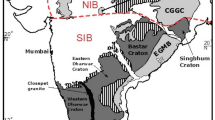Abstract
The Bashkirian anticlinorium of the southwestern Urals shows a much more complex structural architecture and tectonic evolution than previously known. Pre-Uralian Proterozoic extensional and compressional structures controlled significantly the Uralian tectonic convergence. A long-lasting Proterozoic rift process created extensional basement structures and a Riphean basin topography which influenced the formation of the western fold-and-thrust-belt with inversion structures during the Uralian deformation. A complete orogenic cycle during Cadomian times, including terrane accretion at the eastern margin of the East European platform, resulted in a high-level Cadomian basement complex, which controlled the onset of Uralian deformation, and resulted in intense imbrication and tectonic stacking in the subjacent footwall of the Main Uralian fault. The Uralian orogenic evolution can be subdivided into three deformation stages with differently oriented stress regimes. Tectonic convergence started in the Late Devonian with ophiolite obduction, tectonic accretion of basin and slope units and early flysch deposits (Zilair flysch). The accretionary complex prograded from the SE to the NW. Continuous NW/SE-directed convergence resulted finally in the formation of an early orogenic wedge thrusting the Cadomian basement complex onto the East European platform. The main tectonic shortening was connected with these two stages and, although not well constrained, appears to be of Late Devonian to Carboniferous age. In the Permian a final stage of E–W compression is observed throughout the SW Urals. In the west the fold-and-thrust-belt prograded to the west with reactivation of former extensional structures and minor shortening. In the east this phase was related to intense back thrusting. The East European platform was subducted beneath the Magnitogorsk magmatic arc during the Late Paleozoic collision. The thick and cold East European platform reacted as a stable rigid block which resulted in a narrow zone of intense crustal shortening, tectonic stacking and high strain at its eastern margin. Whereas the first orogenic wedge is of thick-skinned type with the involvement of crystalline basement, even the later west-directed wedge is not typically thin-skinned as the depth of the basal detachment appears below 15 km and the involvement of Archean basement can be assumed.
Similar content being viewed by others
Author information
Authors and Affiliations
Additional information
Received: 15 June 1998 / Accepted: 29 November 1998
Rights and permissions
About this article
Cite this article
Giese, U., Glasmacher, U., Kozlov, V. et al. Structural framework of the Bashkirian anticlinorium, SW Urals. Geol Rundsch 87, 526–544 (1999). https://doi.org/10.1007/s005310050229
Issue Date:
DOI: https://doi.org/10.1007/s005310050229




